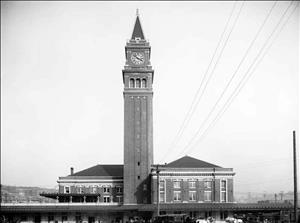On May 10, 1906, Seattle's King Street Station opens. James J. Hill (1838-1916), who purchased the Northern Pacific Railroad in 1901, builds the station between 1904 and 1906. The station supports both the Great Northern and Northern Pacific Railroads. It is fronted by an extended projecting awning covering passengers and the service crew. Behind this rises an impressive structure, designed by Charles Reed and Allen Stem, architects of New York's Grand Central Station. The building's style, sometimes called "Railroad Italianate," incorporates a number of classical details.
Its most outstanding feature was a tall tower, or campanile, on which a prominent clock faced a quickly evolving Seattle. The station's operations were bound to the development of the town, much like a heart pumping life, in the form of new residents and freight, into the growing city. From the expansive drive fronting King Street, horse drawn carriages -- eventually replaced by motor cars -- whisked newcomers away to local hotels and boarding houses.
The waiting areas of this new King Street Station were focal points of the building. The interior was grand, with coffered ceilings and other highly ornate details. Although still compartmentalized like the earlier stations, these spaces suggested that passengers and their experiences were extremely important to the railroad. Rather than a place for loading and unloading cargo, this new station was a distinctive civic portal through which visitors and newcomers passed into a great Western city.

